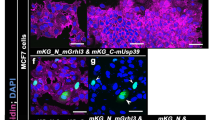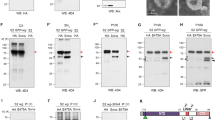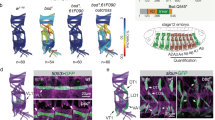Abstract
Establishing cellular polarity is critical for tissue organization and function. Initially discovered in the landmark genetic screen for Drosophila developmental mutants1,2,3,4, bazooka, crumbs, shotgun and stardust mutants exhibit severe disruption in apicobasal polarity in embryonic epithelia, resulting in multilayered epithelia, tissue disintegration, and defects in cuticle formation5. Here we report that stardust encodes single PDZ domain MAGUK (membrane-associated guanylate kinase) proteins that are expressed in all primary embryonic epithelia from the onset of gastrulation. Stardust colocalizes with Crumbs6 at the apicolateral boundary, although their expression patterns in sensory organs differ. Stardust binds to the carboxy terminus of Crumbs in vitro, and Stardust and Crumbs are mutually dependent in their stability, localization and function in controlling the apicobasal polarity of epithelial cells. However, for the subset of ectodermal cells that delaminate and form neuroblasts, their polarity requires the function of Bazooka7,8, but not of Stardust or Crumbs.
This is a preview of subscription content, access via your institution
Access options
Subscribe to this journal
Receive 51 print issues and online access
$199.00 per year
only $3.90 per issue
Buy this article
- Purchase on Springer Link
- Instant access to full article PDF
Prices may be subject to local taxes which are calculated during checkout




Similar content being viewed by others
References
Nüsslein-Volhard, C. & Wieschaus, E. Mutations affecting segment number and polarity in Drosophila. Nature 287, 795–801 (1980).
Jurgens, G., Wieschaus, E., Nüsslein-Volhart, C. & Kluding, H. Mutation affecting the pattern of the larval cuticle in Drosophila melanogaster: II. Zygotic loci on the third chromosome. Roux Arch. Dev. Biol. 193, 283–295 (1984).
Nüsslein-Volhart, C., Wieschaus, E. & Kluding, H. Mutations affecting the pattern of the larval cuticle in Drosophila melanogaster: I. Zygotic loci on the second chromosome. Roux Arch. Dev. Biol. 193, 267–282 (1984).
Wieschaus, E., Nüsslein-Volhart, C. & Jurgens, G. Mutations affecting the pattern of the larval cuticle in Drosophila melanogaster: III. Zygotic loci on the X chromosome and fourth chromosome. Roux Arch. Dev. Biol. 193, 296–307 (1984).
Müller, H.-A. J. Genetic control of epithelial cell polarity: lessons from Drosophila. Dev. Dyn. 218, 52–67 (2000).
Tepass, U., Theres, C. & Knust, E. crumbs encodes an EGF-like protein expressed on apical membranes of Drosophila epithelial cells and required for organization of epithelia. Cell 61, 787–799 (1990).
Schober, M., Schaefer, M. & Knoblich, J. A. Bazooka recruits Inscuteable to orient asymmetric cell divisions in Drosophila neuroblasts. Nature 402, 548–551 (1999).
Wodarz, A., Ramrath, A., Kuchinke, U. & Knust, E. Bazooka provides an apical cue for Inscuteable localization in Drosophila neuroblasts. Nature 402, 544–547 (1999).
Tepass, U. & Knust, E. crumbs and stardust act in a genetic pathway that controls the organization of epithelia in Drosophila melanogaster. Dev. Biol. 159, 311–326 (1993).
Dimitratos, S. D., Woods, D. F., Stathakis, D. G. & Bryant, P. J. Signalling pathways are focused at specialized regions of the plasma membrane by scaffolding proteins of the MAGUK family. BioEssays 21, 912–921 (1999).
Gonzalez-Mariscal, L., Betanzos, A. & Avila-Flores, A. MAGUK proteins: structure and role in the tight junction. Cell Dev. Biol. 11, 315–324 (2000).
Petronczki, M. & Knoblich, J. A. DmPAR-6 directs epithelial polarity and asymmetric cell division of neuroblasts in Drosophila. Nature Cell Biol. 3, 43–49 (2001).
Bhat, M. et al. Discs Lost, a novel multi-PDZ domain protein establishes and maintains epithelial polarity. Cell 96, 833–845 (1999).
Bilder, D. & Perrimon, N. Localization of apical epithelial determinants by the basolateral PDZ protein Scribble. Nature 403, 676–680 (2000).
Kamberov, E. et al. Molecular cloning and characterization of Pals, proteins associated with mLin-7. J. Biol. Chem. 275, 11425–11431 (2000).
Müller, H.-A. J. & Wieschaus, E. armadillo, bazooka, and stardust are critical for early stages in formation of the zonula adherens and maintenance of the polarized blastoderm epithelium in Drosophila. J. Cell Biol. 134, 149–163 (1996).
Tepass, U. Epithelial differentiation in Drosophila. BioEssays 19, 673–682 (1997).
Tepass, U. & Hartenstein, V. The development of cellular junctions in the Drosophila embryo. Dev. Biol. 161, 563–596 (1994).
Tepass, U. Crumbs, a component of the apical membrane, is required for zonula adherens formation in primary epithelia of Drosophila. Dev. Biol. 177, 217–225 (1996).
Grawe, F., Wodarz, A., Lee, B., Knust, E. & Skaer, H. The Drosophila genes crumbs and stardust are involved in the biogenesis of adherens junctions. Development 122, 951–959 (1996).
Wodarz, A., Ramrath, A., Grimm, A. & Knust, E. Drosophila atypical portein kinase C associates with Bazooka and controls polarity of epithelia and neuroblasts. J. Cell Biol. 150, 1361–1374 (2000).
Shen, C.-P., Jan, L. Y. & Jan, Y. N. Miranda is required for the asymmetric localization of Prospero during mitosis in Drosophila. Cell 90, 449–458 (1997).
Klebes, A. & Knust, E. A conserved motif in Crumbs is required for E-cadherin localisation and zonula adherens formation in Drosophila. Curr. Biol. 10, 76–85 (2000).
Wodarz, A., Hinz, U., Engelbert, M. & Knust, E. Expression of Crumbs confers apical character on plasma membrane domains of ectodermal epithelia of Drosophila. Cell 82, 67–76 (1995).
Brenman, J. E. et al. Localization of postsynaptic density-93 to dendritic microtubules and interaction with microtubule-associated protein 1A. J. Neurosci. 18, 8805–8813 (1998).
Shin, H., Hsueh, Y.-P., Yang, F.-C., Kim, E. & Sheng, M. An intramolecular interaction between Src homology 3 domain and guanylate kinase-like domain required for channel clustering by Postsynaptic Density-95/SAP90. J. Neurosci. 20, 3580–3587 (2000).
Den Hollander, A. I. et al. Mutations in a human homologue of Drosophila crumbs cause retinitis pigmentosa (RP12). Nature Genet. 23, 217–221 (1999).
Rashbass, P. & Skaer, H. Cell polarity: nailing Crumbs to the scaffold. Curr. Biol. 10, R234–R236 (2000).
Casso, D., Ramirez-Weber, F., & Kornberg, T. B. GFP-tagged balancer chromosomes for Drosophila melanogaster. Mech. Dev. 91, 451–454 (2000).
Acknowledgements
We are grateful to D. Bilder, M. Bhat, T. Uemura, P. J. Bryant, U. Tepass, E. Knust, E. Wieschaus, Developmental Studies Hybridoma Bank and Bloomington Stock Center for providing fly stocks, antibodies and constructs. We thank S. Barbel, L. Ackerman and S. Younger-Shepherd for technical assistance and M. Rothenberg, D. Cox, S. Abdelilah and U. Tepass for critical comments on the manuscript. B.S. is supported by a grant from the National Institutes of Health. Y.H. is a Research Associate and N.P., L.Y.J. and Y.N.J are Investigators of the Howard Hughes Medical Institute.
Author information
Authors and Affiliations
Corresponding author
Supplementary information

Figure 1
(GIF 105.83 KB)
Protein sequence alignment of the predicted C. elegans protein C10B7.4, SdtA, and mouse PALS-1. Only the alignment of C-terminal half of the proteins is shown. Asterisk indicates where SdtXP96 protein is truncated.
Antibody Dilution Factors for "Methods" section: Dilution factors for primary antibodies were as follows: rabbit anti-Sdt C-terminus 1:100, mouse MAb 22C10 1:200, mouse anti-Crb 1:100 (Cq4, Hybridoma Bank), mouse anti-Arm 1:50 (Hybridoma Bank), mouse anti-Cor 1:500 (Hybridoma Bank), rat anti-DE-Cad 1:20 (from T. Uemura), guinea pig anti-Dlg 1:1000 (from P.J. Bryant), rabbit anti-Baz 1:1000 (ref. 7), rabbit anti-DPar-6 1:500 (ref. 12), rabbit anti-aPKC 1:1000(ref. 21), rabbit anti-Dlt 1:1000 (ref. 13), rabbit anti-Mir 1:1500 (ref. 22), rabbit anti-Scrib 1:1500 (ref. 14), rabbit anti-b-gal 1:3000 (ICN).
Rights and permissions
About this article
Cite this article
Hong, Y., Stronach, B., Perrimon, N. et al. Drosophila Stardust interacts with Crumbs to control polarity of epithelia but not neuroblasts. Nature 414, 634–638 (2001). https://doi.org/10.1038/414634a
Received:
Accepted:
Published:
Issue Date:
DOI: https://doi.org/10.1038/414634a
This article is cited by
-
PAR3–PAR6–atypical PKC polarity complex proteins in neuronal polarization
Cellular and Molecular Life Sciences (2018)
-
Distinct functions of Crumbs regulating slit diaphragms and endocytosis in Drosophila nephrocytes
Cellular and Molecular Life Sciences (2017)
-
CRB2 completes a fully expressed Crumbs complex in the Retinal Pigment Epithelium
Scientific Reports (2015)
-
Crumbs interacts with Xpd for nuclear division control in Drosophila
Oncogene (2015)
Comments
By submitting a comment you agree to abide by our Terms and Community Guidelines. If you find something abusive or that does not comply with our terms or guidelines please flag it as inappropriate.



